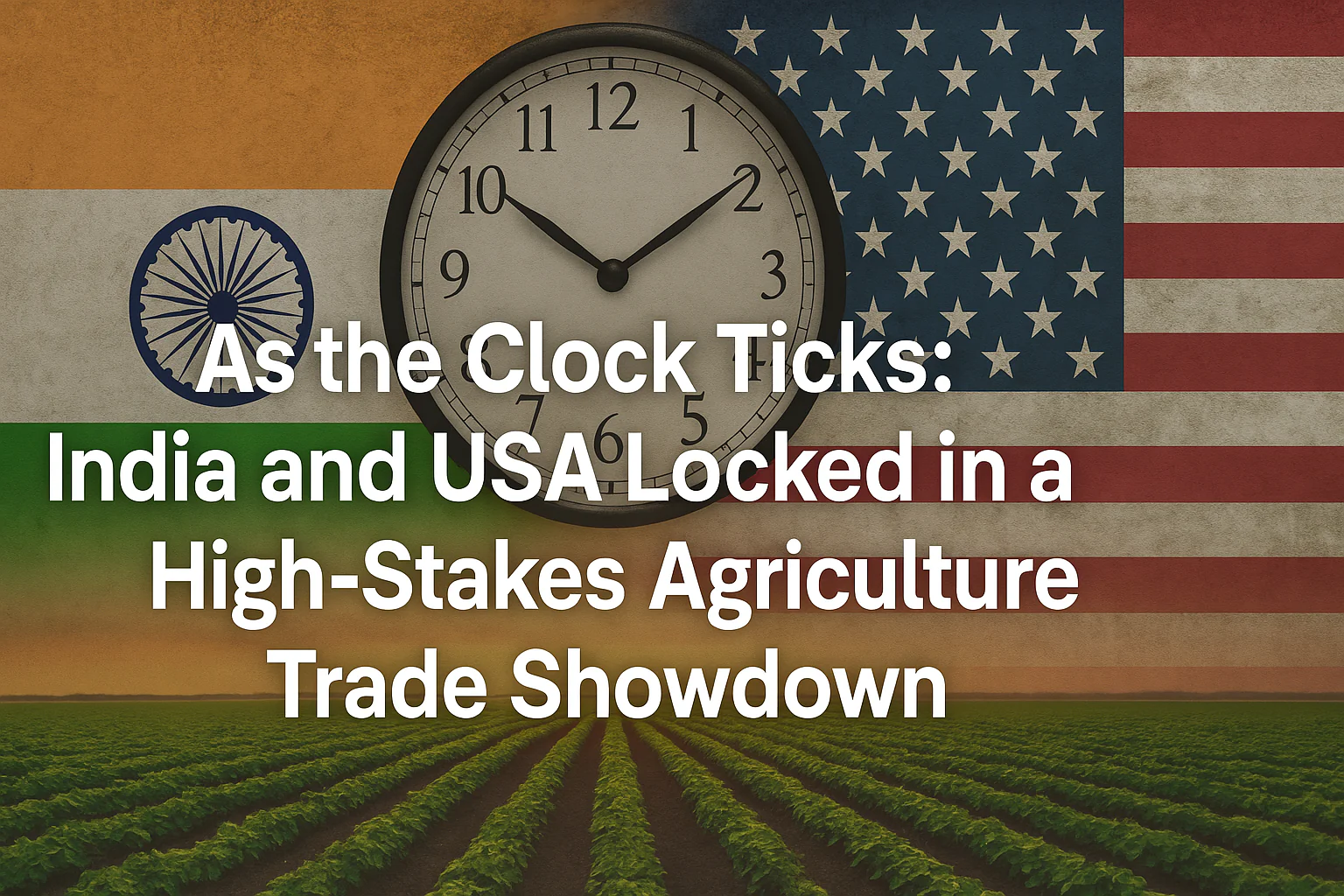A Stake-filled Deadline
As the days to August 1 draw near, the world awaits what will happen to India and the United States as the two nations attempt to solve their recent stalemate. The history of the relationship between these two economic giants is beleaguered with trade wars and tussles on tariffs, but not this round of negotiations. The two parties will appreciate that any deal here might be considered the template to deal with other significant partners, most notably the European Union and Japan. However, when negotiations reach their final days, there remains one most challenging areas of agreement, which is agriculture. Agriculture is the center of the conflict. The agricultural sector of India is not a mere line on the trade agenda, and it involves hundreds of millions of farmers whose interest rests on the sector. The atmosphere that years of sheltered markets, subsidies, and price supports have created does not easily take in shock of foreign competition. Liberalization of Indian agriculture by exposing it to U.S. grain, pulses, and dairy products would drive local prices down and cause political instability in agricultural states. Consequently, New Delhi has many times gone to its center, demanding the maintenance of important protective mechanisms for its rural citizens.
In the other part, Washington considers Indian reluctance as an unacceptable stumbling block to the field of play. According to the U.S negotiators, unless American farmers and agribusinesses are given fair access to the large Indian market, they cannot compete squarely. They caution that all carve-outs will destroy the whole nature of a contemporary trade pact and transform it into a unilateral agreement as opposed to a reciprocal agreement.
Why the U.S. Can Afford to be Stubborn Unless it Has Gains within the Farming Sector
Agriculture in the case of the United States is not a single industry among others. It is the door opener issue that leads to additional compromises on the technology, automobiles, and services. In fear that they can easily lose the momentum when dealing with the EU and Japan, where similar forms of agricultural protection are still upheld, the U.S officials are afraid that by agreeing to a deal, they will not open the farm gates to India. To Washington, a half-baked deal with India would embolden other trading partners who would insist on continuing their barriers, diluting the American impact in the international trading market.
Further, the U.S. administration regards agricultural exports as a rapid fix for the rural constituencies. The large in ticket transactions on high technology products and finance services usually takes a long duration before yielding fruit. However, in the medium term, more exports of soybeans, wheat, and milk products can bring real dividends to the U.S. legislature that will have to stand for re-election. Therefore, the economic and political motivation of Washington in insisting on access to the markets of the farm has implications.
Strategy of India and saving farmers
The negotiating team of India has just come back to India after meeting its counterparts in Washington with a very clear message: it has done all it can, and any agricultural sector liberalization threatens to undermine India’s rural economy. New Delhi has also set a course of phased concessions linked to stringent safeguards behind the scenes; these include small tariff rate quotes and seasonal windows. However, the U.S. negotiators have been refuting such an argument,asattheytposes too much challenge to the American exporters.
India is pursuing a domestic political reality at its core level. The government of the day relies on states that are agriculture-intensive, where agricultural agitations caused by price reduction or flooding of imports can easily intensify. Yesteryear’s memories of sugar cane supply shocks to onion supply shocks remain quite fresh. This is why Indian leaders count that even such a small move as a concession can be unpopular in India as well, in case the voters in the countryside find that their incomes are threatened by foreign competition.
Mini-Deal vs. An Extensive Treaty
With palms clammy in the negotiating rooms, there have been two sides to the question of whether a mini deal based on just a few sectors is worth having to beat the August 1 deadline in New Delhi. The supporters say that by buying at whatever price now, one keeps India on the good side of Washington and opens into more talks in the future. The critics reply that a mini‑deal without serious terms in agriculture would be a policy mistake that would just give the U.S. strength to bargain in the future with nothing substantially gained so far.
In the meantime, both parties admit that a broader Bilateral Trade Agreement (BTA), which might be concluded in September or October, may provide a more balanced package. An agreement of this sort would enable India to package agricultural concessions in combination with declining tariffs in other areas, which would dilute the immediate jolt to the farmers. Then there is the question as to whether the negotiators will be willing to wait out that bigger prize or whether they will race to sign a smaller deal within the tight deadline.
The Trump Factor: When it comes to Trump, Nothing Happens as You Should expect
A wildcard to all this is the tendency by President Donald Trump to spring surprises at the last minute. He has caught negotiators on their heels in the recent months by making future deals with Indonesia and Vietnam, only to then astound by the announcement of the deal having terms that countries such as Indonesia and Vietnam had not formally agreed upon. The phone calls between Mr. Trump and foreign heads of state have surprisingly resulted in receivers on both sides in both cases and left diplomatic staff members running to the text to reconcile their verbalized sentiments.
Considering such a history, Indian officials have not yet taken a similar turn in their talks. According to one well-informed source, we have witnessed the speed at which it rides once the interest of the president is aroused. Mr. Trump may jump in at the eleventh hour and say a deal is made despite the negotiators saying that the negotiation is at an impasse. This would put a colossal pressure on Indian leaders to comply with demands formulated by the White House or be presented as not keen to collaborate with the most powerful nation in the world.
Indonesia and Vietnam experience Lessons
New Delhi should look at the case of Indonesia and Vietnam as a warning. In the former, the trade teams left the table believing that agriculture or another sensitive sector was off limits. But in a few days, the U.S. administration made statements to indicate new market openings and the withdrawal of tariffs. Lawmakers in Hanoi and Jakarta were calling for clarification on what exactly had been settled, and local companies desperately tried to make sense of the announcements.
Analysts caution that India, whose agriculture is much bigger, may find itself in even deeper confusion in case a surprise deal pops in. Problems of logistics in imposing abrupt tariff switches, e.g., adjusting the customs system and training farmers, may provoke general chaos. Besides, the impression that India knelt to political pressure would endanger the domestic backlash and contribute to opposition storytelling.
Motor vehicle Tariffs: One more Bone of Contention
As much as agriculture takes center stage, there is a thorny issue that lies on the negotiating table, and it happens to be the automotive components. The US has demanded zero tariffs on supplies of components sent to India since integrated supply chains need to have duty-free movements. New Delhi, however, wishes to defend its auto-component industry that is under infant industry development, which serves not only local assemblers but also multinational manufacturers based in India.
This unwillingness by India to abolish import duties is wider in scope than an approach that takes care of its local manufacturing. As part of its Make in India scheme, the government has provided incentives to component manufacturers and electric vehicle startups. The officials believe that withdrawing tariffs at a faster rate might stall these plans, and it will become difficult for local companies to attain economies of scale, and hence their ability to compete in the global markets.
Future: Guessing and What Can Be
With the final offers on the table being discussed at the negotiating tables in Delhi and in Washington, several possibilities await the two parties:
- Eleventh-Hour Presidential Intervention: President Trump gets involved, proclaiming a deal that surprises the two parties. There are consequences if India scrambles to ratify the terms or runs a risk of diplomatic fallouts.
- Mini‑Deal on Sectors of Restriction: The two countries settle on a restricted package that does not include agriculture, noting that there would be extended negotiations. This might appease the political schedules at the expense of the enforcement of the main interests.
- No Deal August 1: Negotiations break down, further unsettling exporters and risking reprisals against them: a rise in tariffs, or suspended investment. Nonetheless, such a result can encourage the scholars back to the negotiation table with a stronger sense of urgency.
- Broad-based BTA: Through the deadline, negotiators put quality over rush and delayed the last-minute signature until they ironed out the details of how agriculture and industry safeguards could be obtained with thoroughness. That would probably slow down access to the market, but would result in a more long-term agreement.
Every choice has its dangers and its benefits. An agreement hastily implemented to beat the deadline can be susceptible and needs a lot of amendments throughout the text, with subsequent procedures. On the other hand, a new round of negotiations that results in a serious agreement at a later date would entail a bigger payoff in the longer run, but it will subject both governments to the charge of failing to meet a publicly stated deadline.
Conclusion: The Change in Trade
India and the United States will have to stand the test of the days ahead. The negotiations raise wider issues of what it means to be sovereign, what domestic politics is served by demands concerning tariffs and quotas, and what form global trade will take. Will India hold its ground in respect to defending its farmers, or will it compromise in order to preserve larger economic relations? Does the U.S. administration want to have agricultural victories in its heartland to win across the board?
With the clock counting down to Well, one thing can be sure Than that the result of these talks will have a major echo well past bilateral relations. It will affect the approach to involving emerging economies in the activities of the global giants, the development of agricultural protection in the age of free trade, and how presidential leadership can modify the direction of complicated negotiations. Amid a surprise announcement or a bruising consensus hammered, the India-U.S. trade saga is all set to unveil the next installment under the spotlight of the world.




